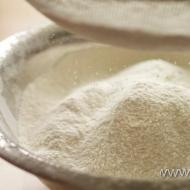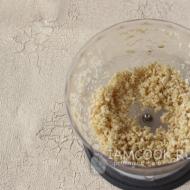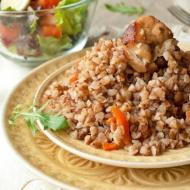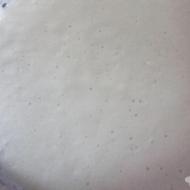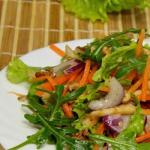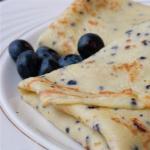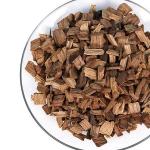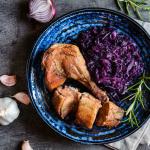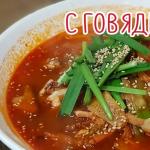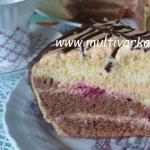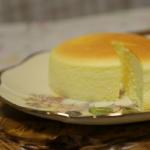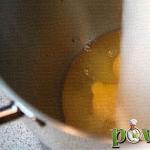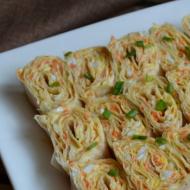
Is it possible to eat honey mushrooms with a dark cap? False honey mushrooms and edible photos, how to distinguish real honey mushrooms from false ones. Meadow honey mushrooms: photo and description
Honey mushrooms are popularly called completely different types of mushrooms, because the name “honey agaric” itself means “mushroom on a stump.” But honey mushrooms settle not only on stumps, but also on living trees, thereby destroying them. But there is an exception - this is the meadow honey fungus (meadow mushroom), it prefers to grow in meadows, clearings and pastures.
Mushroom pickers are most familiar with autumn, summer, winter and meadow honey mushrooms. Some of them do not belong to the genus Openok, but we will also get to know them all.
Genus Honey fungus (Armillaria)
Autumn honey fungus, true (Armillaria mellea)
“The honey mushrooms are gone,” mushroom pickers say to each other. If there is already a wave of honey mushrooms, there will be enough mushrooms for everyone. At this time, stumps and trees are dotted with hundreds of honey mushrooms growing close to each other. Autumn honey fungus is the only mushroom that is not looked for, but rather collected, like blueberries or raspberries.



Young honey mushrooms with ununfolded caps, covered from below with a white film, go into the basket entirely; with older ones, whose caps have unfolded and the film has formed a ring on the stem, only the caps are cut off. Their legs become tough and tasteless. Old mushrooms, from which white spores spill out onto the caps of neighbors, should not be taken. Their loose flesh acquires an unpleasant odor.




This yield is not surprising if we recall the developmental features of the fungus. Or rather, its mycelium - after all, a mushroom is just a fruiting body, and a mycelium is an organism itself, like, for example, an apple and an apple tree - so, the largest organism on Earth is precisely the mycelium of the honey fungus! It covers an area of 9 square kilometers (!), is about 2500 years old and weighs (according to indirect estimates) more than 6000 tons!!! So the sea giant - the blue whale - is 30 times smaller!
The color of the autumn honey fungus's cap varies greatly from light ocher to reddish-brown and olive-brown. The middle of the cap is usually darker. The entire surface of the cap is densely dotted with dark scales. It is believed that the color of the cap depends on the substrate on which the mushroom lives. Honey mushrooms growing on poplar, white acacia, and mulberry have a honey-yellow hue, on oaks - brownish, on elderberries - dark gray and on coniferous trees - reddish-brown.
The plates of young mushrooms are light, yellowish. With age they darken and become covered with brown spots. The stalk in the upper part is light, yellowish, like the plates, in the lower part it is thickened, brownish, in old mushrooms it becomes very dark and hard. There is a white membranous ring on the stem. The ring is strong, woolly, often double.
Autumn honey fungus is widespread across all continents. It can grow on the wood of many trees, both coniferous and deciduous, not only on the trunks, but also on the roots.
Autumn honey fungus is one of the most versatile mushrooms in terms of how it can be used in food. It goes into soups, roasts, marinades, salts, and drying.
The following types of honey fungus differ in some external (as well as morphological) characteristics from the autumn honey mushroom, but in terms of taste, they are very similar.
Honey fungus (Armillaria gallica, Armillaria lutea)
The shape of the cap is bell-shaped, then convex with a characteristic tubercle in the center. The color of the cap varies from brownish, ocher-brown to brown. The entire cap is covered with small hairy scales. The color of the scales is yellowish-green, olive-brown or gray.




Leg at the base with a club-shaped thickening. Covered with gray-yellow scales. The leg is brown below, yellow above the ring, sometimes whitish. Often the leg is surrounded by remnants of a yellowish blanket. The ring of the honey mushroom is thin and cobwebby, white or yellow.



This species of honey fungus does not settle on living trees, but prefers burnt wood, stumps and dead wood of deciduous trees. Grows in small clumps, often solitarily.
Tuberous honey fungus (Armillaria cepistipes)
The cap is up to 10 cm in diameter, with a smooth surface. At the beginning of development, the cap is dark, brownish-gray, then becomes paler, more pinkish-dark yellow, cream or bakery color. It is characteristic of this species that the dark scales are crowded in the center of the cap, while the edge of the cap is without scales and is always smooth. The leg is quite thin, slender, tuberous at the base. When young, it turns yellow at the base and then turns brown. The ring is thin and fragile and quickly disappears.



The tuberous honey fungus lives in deciduous forests and is found on the soil in the grass.
Dark honey fungus (Armillaria ostoyae)
The cap is dark brown in color, with dark blackish scales. The leg is cylindrical, usually thicker, sometimes curved, pale brown, brown in color. Over the entire surface of the leg there are white scales, which over time become dirty brown. The ring of the dark honey mushroom is strong and thick.




This mushroom grows in mixed and also coniferous forests, preferring coniferous species, and is found on stumps. tree trunks and on the remains of wood that has rotted. It grows in late summer and autumn.
Northern honey fungus (Armillaria borealis)
This mushroom is distinguished by its olive-honey shade of cap, its color varies from yellow-brown to orange-brown, often with an olive tint. The center of the cap is often golden yellow. The diameter of the cap is from 2 to 8 cm. The scales on the cap are either the same color or slightly darker, yellowish-cream, brown, olive. The color of the leg is ocher to brownish, with yellowish-white pubescence.




These mushrooms grow in large groups and are found on both deciduous and coniferous trees.
Honey mushrooms too
According to their morphological characteristics, these mushrooms do not belong to the genus Honey fungus (Armillaria), but according to their external characteristics they are similar to honey mushrooms, they also grow in groups on stumps and trees, so according to tradition, we will also call them honey mushrooms.
Summer honey fungus (Kuehneromyces mutabilis)
This is an edible mushroom. It appears at the very beginning of summer, in June, when there are still few edible mushrooms in the forest. It grows on stumps, logs, and all kinds of rotten deciduous trees. It can settle near human habitation - on long-cut but unused logs, on the frames of old wells, even on bridges across ditches and streams - in a word, it does not disdain anything made of wood.
Summer honey fungus can be found in the forest almost constantly throughout the summer and autumn, until the first frost.
It is not so difficult to distinguish these mushrooms from others growing on stumps. The summer honey fungus's cap is almost always two-colored: in the middle it is light leather-yellow, at the edges it is darker translucent, as if saturated with water.




The leg of the honey mushroom is also two-colored: above the ring it is light, yellowish, smooth, under the ring it is very dark, reddish-brown or brown, with short, clean protruding scales. The legs are curved, which is typical for many mushrooms growing on stumps in large bunches. The ring on the stem is not wide, brown. With age, it darkens, presses against the leg, sometimes disappears, leaving a clear brownish mark on the leg.
The pulp of the summer honey fungus is thin, and it cannot be called as versatile in cooking as the autumn honey mushroom. This mushroom is mainly used in soups; they turn out tasty, fragrant and transparent.
Honey fungus (Marasmius oreades)
Meadow mushrooms are early mushrooms, they appear already in early June, or even at the end of May, and persist until late autumn. Missing mushrooms over the winter, mushroom pickers walk through the clearings with scissors and collect these small mushrooms.
I don’t know why these mushrooms were called honey mushrooms, because they do not grow on stumps at all, but on meadows and clearings, grassy slopes of ravines. Perhaps because of their friendliness, because these mushrooms are poured out in abundant groups.




The meadow honey fungus belongs to the genus of non-rotting mushroom. This is a small mushroom, its stem is thin, very hard and fibrous. Because of their mushroom smell, meadow mushrooms are mainly used for broths and soups. They are also dried.
Spring honey fungus (Collybia dryophila)
Or wood-loving collibia. A bit similar to the meadow honey fungus in the size and color of the cap, with a thin stem. But in the meadow honey fungus the plates are rare, relatively wide, cream-colored, while in the wood-loving collibia they are very frequent, narrow, and light yellow.




Like the meadow honey agaric, collibia appears early, in late May - early June, but it grows in forests, on fallen leaves, decaying stumps, which is why it got its name spring honey agaric.
These crumbs have a nice mushroom smell. but you will have to collect quite a lot of them so that there is at least enough for soup. Still, collibia is mushroom-free.
Winter honey fungus (Flammulina velutipes)
Winter honey fungus grows in October-November. It grows in large "bouquets". Winter honey fungus can be found both in the forest and in the city on old deciduous trees with damaged bark and wood, on stumps, and on fallen trunks.




The caps of honey mushrooms are smooth, shiny, pure yellow or golden in color, with a darker brownish center. The legs of the mushrooms under the cap are yellow-ochre, lower down they get darker and darker. The surface of the leg is velvety. The stems of mushrooms are hard, fibrous, inedible. The caps are fried, pickled, made into soups, and dried. Yes, if you haven’t collected any other mushrooms for the winter, then the winter honey fungus will at least make up for the loss a little with its last mushroom smell.
Yellow-red honey fungus (Tricholomopsis rutilans)
Or yellow-red. This large, beautiful mushroom grows on the stumps of coniferous trees, or near the stumps, on the roots. The main color of the mushroom is yellow, but the cap and stem are densely covered with numerous velvety-fibrous dark red scales.




The mushroom, although harmless, is tasteless. It has the smell of rotting wood and a bitter taste.
False honey mushrooms
In addition to edible honey mushrooms, you need to remember that there are double mushrooms or mushrooms similar to honey mushrooms, which are not only inedible, but even poisonous.
The poisonous counterparts of edible honey mushrooms are brick red honey fungus And sulfur-yellow honey fungus. They differ from edible ones primarily in their smell, the color of the cap and plates, as well as the structure of the stem.
There is even a poem about this:
Has an edible honey fungus
On the leg there is a ring made of films,
And the false mushrooms
Legs bare to toe.
Brick red honey fungus (Hypholoma sublateritium)
These mushrooms grow throughout the summer until late autumn. This large, dense and bright mushroom can only be confused from afar with autumn or dark honey fungus. Upon closer inspection, it immediately becomes clear that this is not a honey fungus at all. The mushroom's cap is orange, yellow at the edges with hanging flakes from a private blanket. It grows in large groups on stumps and rotting wood of deciduous trees.
An attentive mushroom picker will not confuse edible mushrooms from false ones; they have many differences.
The first thing you need to pay attention to is the color of the records. In young false honey mushrooms they are yellowish rather than white or cream. With age, the plates acquire an olive tint. As they age, the plates turn brown, even blacken, but nevertheless have a green tint.




Secondly, they are distinguished from edible honey fungus by their legs, which are not widened downwards, like those of the autumn honey fungus, and not dark-scaly, like those of the summer honey mushroom, but smooth. sometimes narrowed at the base, browning at the bottom. There is no ring on the legs of false honey fungus, only a faint trace of the private blanket in the form of small brown or black stripes around the circumference.




Thirdly, the caps of false mushrooms do not have pronounced scales, like edible honey mushrooms. The surface of the cap is smooth.
The brick-red false fungus mushroom is bitter, but we do not recommend tasting it, it is poisonous.
Sulphur-yellow honey fungus (Hypholoma fasciculare)
This mushroom is smaller than the previous one. It can be confused with summer honey fungus. The same yellowish, convex cap, half-spread with age, has a reddish tint in the center. The bright sulfur-yellow color of the plates and cap gives this mushroom its name. The difference is that the plates of the false foam become green with age. The summer honey fungus has a leg with pronounced white specks on a brown background, while the false honey mushroom has a thin, smooth, curved, yellow leg, turning brown only at the base. The false foam does not have a ring.




It grows from August to October on dead trees, participating in their decomposition, mainly prefers coniferous trees, but can also be found on deciduous trees. Fruits in small groups. The mushroom is deadly poisonous! Contains toxins, like the toadstool.




Galerina fringed is sometimes mistaken for summer honey fungus, which also grows on dead wood in dense colonies.
Dedicated to our readers - when collecting honey mushrooms, be careful, look at the structure and composition of the mushroom, because mushrooms are something that even the devil himself doesn’t joke with...
Tags:
Every year, as the mushroom season approaches, novice mushroom pickers are interested in what certain edible mushrooms look like. And this is very correct and important. You need to not only know, but also be able to distinguish “good” mushrooms from “bad” ones, since the consequences of eating a poisonous (false) mushroom can be quite sad.
Honey mushrooms are very tasty mushrooms, so today’s article is dedicated to them. We will tell you and show you in the photo what edible honey mushrooms look like. We will also pay attention to false honey mushrooms in order to be able to distinguish them from real ones and not put them in our basket. Perhaps we’ll start with them...
What false (poisonous) honey mushrooms look like
The most common honey fungus is the brick-red and sulfur-yellow honey fungus. They can be distinguished from edible honey mushrooms by their unpleasant smell, the color of the mushroom cap and the plates under it, as well as by the structure of the stem. All inedible mushrooms have a stem without a ring, while the stem of edible mushrooms has a skirt. The cap is convex, then half-spread, yellow, with a reddish tint in the center. The plates are adherent, sulfur-yellow, then greenish-olive.
Sulfur-yellow false honey fungus (photo)
In the photo there is a brick-red poisonous honey fungus
|
|
|
What does autumn honey fungus look like in reality?
What edible honey fungus actually looks like
The cap of edible honey mushrooms can be from 3 to 10 centimeters; its shape resembles a tea saucer. A young honey mushroom may have a beautiful convex cap with a tubercle in the middle. Most often, his hat is yellow-brown in color and covered with numerous dark scales. Dark fawn or light yellowish rare plates are placed evenly under the hat. The pulp of such mushrooms looks like a white, loose mass with a pleasant smell and sourish-astringent taste. But you shouldn't try raw mushrooms. The leg can reach a thickness of 0.8-1 cm, and a height of up to 7-10 cm. Sometimes the leg can be denser - up to 1.5 cm, which thickens towards the base and is covered with brownish-brownish small scales and retained white membranous ring. The presence of a ring on the stem (skirt) on the stem of honey mushrooms is the most reliable way to distinguish a genuine mushroom from a false one.
False honey mushrooms pose a huge danger, since they are very similar to edible ones, and they grow in the same places: on stumps, felled trees, snags.
These mushrooms can cause poisoning and even be fatal. Therefore, when going to the forest to pick mushrooms, you need to know exactly what false mushrooms look like and what are real.
False honey mushrooms
Description of false mushrooms
Forest mushrooms, honey mushrooms, are very popular due to their taste. Moreover, they can be collected throughout the entire mushroom season, from summer to late autumn. And they grow quickly and in whole groups. Cut mushrooms grow back within two weeks. They are eaten fresh, pickled and salted for the winter, but false honey fungus can also be found among them, which, without knowing some of its characteristics, is difficult to recognize among edible honey mushrooms.
In total, more than 20 species of these mushrooms are known, but we only eat summer, autumn and winter honey mushrooms. But they all have their poisonous relative.
Let's look at how to identify poisonous mushrooms from edible ones.
The false honey fungus differs from its summer and autumn relatives in the following characteristics:

- Usually honey mushrooms have a special mushroom aroma, but if they emit a foul, earthy odor, this is a clear sign of a false mushroom;
- Edible mushrooms also differ from false mushrooms in the shade of their caps; the poisonous mushroom is much brighter than the normal one. Its caps can be sulfur yellow or brick red;
- False mushrooms also differ from real mushrooms in that their caps have a smooth surface, but edible honey fungus at an early age is covered with scales, which disappear as the mushroom ages, but even a novice mushroom picker must remember that eating old mushrooms that grow on stumps and trees are also dangerous;
- It is also worth paying attention to the color of the internal plates. In false mushrooms they are yellow or greenish and even olive-black. If you compare them, you can see that the plates of a real honey mushroom have a cream or yellowish-white tint.
An inexperienced mushroom picker, and even more so a beginner, at first glance is unlikely to determine how mushrooms differ in smell or color, but the ring on the stem is perhaps the main and sure sign that will allow you to collect only real honey mushrooms in the basket.
It is quite difficult to identify false mushrooms among winter mushrooms. Since neither one nor the other has a so-called “skirt”. The pictures also give a general idea of mushrooms.
 Differences
Differences Let's look at the brightest and most common representatives in the category of fake honey mushrooms.
Honey fungus brick-red . This type of poisonous mushroom is typical for the summer honey mushroom season. Externally, the mushrooms are very similar. They love to grow on old stumps of alder, aspen, linden, and birch. They differ primarily in that they do not have a ring on the stalk, which, unlike a real mushroom, is quite elongated with a narrowed base and is colored yellowish. The irregular (false) honey fungus has a round, convex cap with a diameter of up to eight centimeters (photo below).

Its shade is brownish-red or orange, and light fringe is noticeable along the edges - these are the remains of a mushroom blanket. Also, unlike real mushrooms, the red honey fungus loves well-lit areas.
Honey fungus is sulfur-yellow. This is one of the most poisonous types of false mushrooms. Not only beginners, but also experienced mushroom pickers can inadvertently bring it home. Its distribution area is quite wide. It grows in deciduous forests and coniferous forests, in fields, and often loves meadow stumps. False mushrooms grow in huge groups, almost completely covering old rotten stumps. They are very similar to summer and autumn honey mushrooms, so they often end up in the basket. When picking mushrooms, they should be carefully inspected. False ones should differ from real ones, in addition to the absence of a ring-skirt on their stem, by the following features:
- color and shape of the cap;
- shades of plates;
- sizes.
The poisonous mushroom does not grow above ten centimeters, its legs are thin and pale. The hat, on the contrary, is quite strong and large, which clearly resembles an open umbrella. It has a peculiar hue: a yellowish or pale red center, and the rest is white. In addition, the cap of the false mushroom has a smooth structure, which is not at all typical for noble mushrooms.
You should also carefully examine the underside of the mushroom. The “wrong” honey fungus is characterized by plates of gray, gray-green, dark yellow, and black. And if you break the mushroom into pieces, you can see that the pulp has a yellowish tint and an unpleasant odor, which is completely uncharacteristic of edible mushrooms.
In addition to the poisonous ones, among the false ones there is a certain species that is classified as conditionally edible. These mushrooms are less toxic and, if properly cooked, can be suitable for consumption. Although, it is better to give preference to real mushrooms and not risk your health.
Conditionally edible mushrooms, which are also classified as false mushrooms, can be identified by the following characteristics. And so, the most common representative of this category is Psatirella water-loving. This mushroom has a watery texture. It appears in the fall, during a period of high humidity, not only on stumps, but also around them. Grows in small groups. This is a characteristic feature that is worth paying special attention to, because honey mushrooms usually grow in large families. The mushrooms themselves are small, only eight centimeters in height, and the cap does not exceed five centimeters. At the same time, it is quite thin, slightly curved and without scales. Psatirella has a light brown stem and a dark brown cap; inside the mushroom there is watery pulp of the same brown color.
The Kandolla mushroom is also a false mushroom. Although it is believed that it can be eaten after proper preparation, it is still better to abandon this idea, since poisoning with false mushrooms is very dangerous. Kandolla grows in deciduous forests on stumps, trees and near them throughout the entire mushroom season. Young specimens have brownish caps with scales, which disappear as the mushroom ages. A characteristic feature is the appearance of the cap: it is flat and only has a small protrusion in the middle and wavy edges. The mushroom grows on a thin nine-centimeter stalk. The cap, up to five centimeters in diameter, has pale purple and darkish plates on the inside.
How to distinguish between false and edible mushrooms can be seen in the video:
Poisoning by false mushrooms
Symptoms of poisoning with false mushrooms most often appear within an hour, but depending on the individual characteristics of the body and objective factors, they can make themselves felt much later, within ten or twelve hours. Let us note the fact that the symptoms of poisoning with any mushrooms, and even edible ones (if they are stored and prepared incorrectly) are almost identical. First of all, it is observed:
- intoxication of the body, nausea and vomiting appear;
- dizziness;
- abdominal pain;
- loose stools;
- drowsiness appears.
If the onset of these symptoms was preceded by the consumption of mushrooms, you should immediately call an ambulance. Because in case of mushroom poisoning, intoxication of the body develops rapidly; the poison affects not only the gastrointestinal tract, but also the central nervous system and the circulatory system. A person can fall into a coma, after which the heart stops, resulting in death.
Before the ambulance arrives, you need to rinse your stomach at home (this is provided that the symptoms appeared within an hour after eating mushrooms), to do this, drink two liters of water with a weak solution of potassium permanganate and induce vomiting, you also need to drink a laxative and drink activated charcoal .
Under no circumstances should you use drugs that stop vomiting or diarrhea, as this will only worsen the situation, because the body must remove toxins.
You cannot self-medicate; after providing first aid, you should immediately go to the hospital.
Detailed information about honey mushrooms: types, photos, places and terms of growth, distinctive features of inedible ones.
Honey mushrooms are the most common mushrooms. They are familiar even to a novice mushroom picker. But their diversity sometimes casts even scientists involved in the study of mushrooms into doubt when determining their species. But honey mushrooms are not only edible, but also deadly poisonous.
Therefore, before you go into the forest, familiarize yourself with the main, most common types of honey mushrooms.
Types of edible honey mushrooms - Assumption, summer, meadow, Chinese, autumn, winter, thick-legged, slimy honey mushrooms, honey mushroom: description, photo

Summer (Kuehneromyces mutabilis)

Meadow (lat. Marasmius oreades)

Edible scale (lat. Pholiota nameko)

Autumn (Armillaria mellea) or Assumption

Winter (Flammulina velutipes)

Thick-legged (lat. Armillaria lutea, Armillaria gallica)

Mucous or udemansiella mucosa (lat. Oudemansiella mucida)

Common garlic (lat. Mycetinis scorodonius, Marasmius scorodonius)
How to identify false honey mushrooms: signs
- The most important sign is that false mushrooms do not have a membranous ring (skirt) on the leg
- Have an unpleasant earthy odor
- The color of the caps is bright
- Smooth caps without scales
- The plates are yellow, becoming greenish or olive-black as they grow
- They taste bitter when eaten
How to distinguish toadstools from real honey mushrooms?

note
| Edible | False |
| Ring on the leg | |
|
|
| Leg height, cm | |
|
|
| Plates | |
| Pale yellow or cream |
|
| Hats | |
|
|
| Taste qualities | |
|
|
| Smell | |
|
|
| If it gets into water | |
|
|
On what stumps do honey mushrooms grow?


Be carefull
Poisoning can be caused by both poisonous and edible varieties of honey mushroom, the latter if their quality is poor.
- The first symptoms of poisoning with rotten boiled or poorly pickled edible specimens appear 1-2 hours after their use, in the form of:
- Nauseous attacks and vomiting
- Diarrhea
- Pain in the stomach and intestinal areas
- Heartburn and belching
- General weakness
- Headache
- Increased body temperature to 37.5 degrees
- Increased gas formation in the intestines
- False honey mushrooms, mistakenly taken into food, cause the first symptoms of poisoning within 15-20 minutes. They develop brightly, instantly disturb the patient’s condition, and are expressed:
- Severe dizziness and loss of coordination
- Nausea and vomiting. First, food residues come out, and then gastric juice and bile
- Breathing disorders - turns into superficial, frequent, accompanied by shortness of breath, lack of air is felt
- Bright mirages - auditory, tactile or visual
- Copious and repeated diarrhea
- Convulsions - partial or general
- Impaired awareness, even coma is possible
Popular gifts of nature are extremely appetizing in any form:
- fried
- stewed
- pickled
- salty
A successful harvest harvested on time will allow you to enjoy yourself and treat your guests with the healthy gifts of nature in the winter.
Video: Mushrooms of October: autumn honey mushrooms
Wild mushrooms everywhere attract special attention from fans of original food, because they can be boiled, fried, pickled, salted and dried. Unfortunately, in nature there are edible and false honey mushrooms, which often end up in the basket of inexperienced mushroom pickers. Before going out into the forest, it would be wise to become more familiar with the honey mushrooms that grow in the area where we live.
The main symptoms of poisoning with inedible honey mushrooms occur several hours after eating them. A sharp headache, nausea, dizziness, and intestinal spasms signal a problem.
Edible and false honey mushrooms: criteria for distinction
 Who doesn’t love going into the forest to pick mushrooms and having a basket or bucket full of them a few hours later? This is exactly the case with honey mushrooms. After all, they grow in huge families of several dozen pieces, located in a small area. In order for the hike to end successfully, it is important for everyone to know how to distinguish honey mushrooms from false honey mushrooms. Otherwise, joy may be replaced by the bitterness of food poisoning. First, let's look at edible and safe specimens. And then, let’s take off the “mask” from the false mushrooms that strive to end up in the basket of inexperienced mushroom pickers.
Who doesn’t love going into the forest to pick mushrooms and having a basket or bucket full of them a few hours later? This is exactly the case with honey mushrooms. After all, they grow in huge families of several dozen pieces, located in a small area. In order for the hike to end successfully, it is important for everyone to know how to distinguish honey mushrooms from false honey mushrooms. Otherwise, joy may be replaced by the bitterness of food poisoning. First, let's look at edible and safe specimens. And then, let’s take off the “mask” from the false mushrooms that strive to end up in the basket of inexperienced mushroom pickers.
 Experts advise paying attention to several criteria that help you notice the dangerous difference between edible and false honey mushrooms:
Experts advise paying attention to several criteria that help you notice the dangerous difference between edible and false honey mushrooms:
- Aroma. If you have doubts when collecting forest gifts, you can sniff the cap of the fruit to inhale its scent. The edible mushroom has a pleasant aroma, and the “imitator” has notes of rotten soil.
- Leg. Young honey mushrooms have a leg, which is decorated with a film “skirt”. It is located next to the hat. Mushrooms similar to honey mushrooms do not have such “decoration”.
- The color of the records. In edible mushrooms they are yellowish or cream colored. False honey mushrooms boast a bright yellow, olive or earthy hue.
- External texture of the cap. In young edible honey mushrooms, the surface of the cap is often scaly. False mushrooms have a smooth surface.
- Color of the surface of the mushroom. Edible honey mushrooms have light brown colored caps. “Imitation” mushrooms are distinguished by more elegant shades: the bright color of sulfur or red brick.
Of course, all these criteria are very important, but if after research doubts remain, we apply the main principle: “If you’re not sure, don’t take it!”
Inexperienced mushroom pickers should not go for honey mushrooms alone. Good advice from a specialist will help you avoid falling into the trap of greed and take only.
Features of your favorite autumn mushrooms
 To learn to distinguish edible and false honey mushrooms from each other, it is important to have a good understanding of the growth characteristics of these plants. As you know, in nature there are many different types of honey mushrooms. But they are all united by the common characteristics of these cute mushrooms. It turns out that it is not enough to know what mushrooms look like from the outside. It is important to get to know them better.
To learn to distinguish edible and false honey mushrooms from each other, it is important to have a good understanding of the growth characteristics of these plants. As you know, in nature there are many different types of honey mushrooms. But they are all united by the common characteristics of these cute mushrooms. It turns out that it is not enough to know what mushrooms look like from the outside. It is important to get to know them better.
 Edible mushrooms most often grow in large groups near stumps or with tree roots protruding from the soil. When they just emerge from the soft forest soil, they are decorated with a semicircular cap. In older specimens, it completely changes shape. Now it looks more like a wide plate turned upside down.
Edible mushrooms most often grow in large groups near stumps or with tree roots protruding from the soil. When they just emerge from the soft forest soil, they are decorated with a semicircular cap. In older specimens, it completely changes shape. Now it looks more like a wide plate turned upside down.
 Looking at the photos of false and edible honey mushrooms, you can notice differences in the coloring and size of the caps. These can be the following shades:
Looking at the photos of false and edible honey mushrooms, you can notice differences in the coloring and size of the caps. These can be the following shades:
- orange;
- rusty yellow;
- brownish;
- honey yellow.
The diameter of the cap reaches up to 10 cm. Its outer part is covered with scales, which partially disappear over time. The dorsal plates of the cap of young honey mushrooms are usually light-colored. In mature specimens they are colored brown or yellowish.
If you carefully examine the legs of edible specimens, you will notice that they are hollow inside. In addition, they are decorated with a leathery ring, which was formed from the protective covering of a young mushroom.
The pulp has a light brown color, which does not change even when water gets on it.
It is better to know the enemy by sight
 With the onset of autumn, when the sun still pampers people with its warm rays, many go to the forest to pick mushrooms. Particularly attractive are places with fallen trees or low stumps covered with many cute mushrooms. But in order not to run into disguised “enemies”, it is worth getting to know the false honey mushrooms better. How to distinguish them from their edible relatives and not accidentally put them in the basket and then on the table? Let's look at some types of such inedible options.
With the onset of autumn, when the sun still pampers people with its warm rays, many go to the forest to pick mushrooms. Particularly attractive are places with fallen trees or low stumps covered with many cute mushrooms. But in order not to run into disguised “enemies”, it is worth getting to know the false honey mushrooms better. How to distinguish them from their edible relatives and not accidentally put them in the basket and then on the table? Let's look at some types of such inedible options.
Inexperienced fans of forest gifts should take into account that false honey mushrooms can grow next to edible specimens in the same friendly families.
 At the end of August, on the forest edges, among old stumps and fallen trees, autumn flowers grow in large groups. The photo helps to see this disguised “enemy” in all its glory. Most often, its convex cap ranges from 4 to 8 cm. When mature, it opens up a little, thereby becoming similar to its relatives. The cardinal difference is the brick-red color of the outer covering of the cap. The pulp of the mushroom has a bitter taste and pale yellow color.
At the end of August, on the forest edges, among old stumps and fallen trees, autumn flowers grow in large groups. The photo helps to see this disguised “enemy” in all its glory. Most often, its convex cap ranges from 4 to 8 cm. When mature, it opens up a little, thereby becoming similar to its relatives. The cardinal difference is the brick-red color of the outer covering of the cap. The pulp of the mushroom has a bitter taste and pale yellow color.
Kandollya
 These false honey mushrooms “settle” in large families near the stumps and roots of centuries-old deciduous trees. They appear in late spring and bear fruit until early September. A distinctive feature of young mushrooms of this species is their bell-shaped cap. Over time, it opens up like an umbrella, on top of which there is a convex tubercle. The edges of the cap of this camouflaged mushroom are framed by a light fringe that remains from the protective blanket. Its diameter varies from 3 to 7 cm. The color is most often yellow-brown, although it can be whitish.
These false honey mushrooms “settle” in large families near the stumps and roots of centuries-old deciduous trees. They appear in late spring and bear fruit until early September. A distinctive feature of young mushrooms of this species is their bell-shaped cap. Over time, it opens up like an umbrella, on top of which there is a convex tubercle. The edges of the cap of this camouflaged mushroom are framed by a light fringe that remains from the protective blanket. Its diameter varies from 3 to 7 cm. The color is most often yellow-brown, although it can be whitish.
 This autumn honey fungus is a truly dangerous double. The name and photo of the mushroom tell a lot about it. As a rule, sulfur-yellow honey fungus grows on trunks, branches, stumps and around deciduous and coniferous trees. Depending on climatic conditions, it actively bears fruit until the first October frosts. At the same time, it grows in numerous groups.
This autumn honey fungus is a truly dangerous double. The name and photo of the mushroom tell a lot about it. As a rule, sulfur-yellow honey fungus grows on trunks, branches, stumps and around deciduous and coniferous trees. Depending on climatic conditions, it actively bears fruit until the first October frosts. At the same time, it grows in numerous groups.
His bell-shaped hat eventually transforms into an “open umbrella” and is distinguished by the following coloring:
- yellow;
- grayish yellow;
- yellow-brown.
There is a contrasting darkening in the center of the cap. If such mushrooms end up on the dinner table of fans of forest gifts, the outcome may be irreparable. Therefore, knowing the dangers of false honey mushrooms helps you stay away from them.
Royal honey mushrooms
 This type of mushroom rightfully deserves special attention, since it is an exquisite delicacy for fans of forest gifts. Edible specimens have a wide, bell-shaped cap that is rusty yellow or olive in color. The entire fruit is abundantly covered with brown scales, resembling flakes or graceful tubercles. And the flesh of royal honey mushrooms is yellow.
This type of mushroom rightfully deserves special attention, since it is an exquisite delicacy for fans of forest gifts. Edible specimens have a wide, bell-shaped cap that is rusty yellow or olive in color. The entire fruit is abundantly covered with brown scales, resembling flakes or graceful tubercles. And the flesh of royal honey mushrooms is yellow. 
It is best to collect mushrooms that have slimy caps that are smooth to the touch. If the fruit has a dark shade, it means it is no longer young.
 Despite such popularity, disguised false royal honey mushrooms are also found in nature. They often grow on the sites of old ashes or fires that are already overgrown with grass. And the pulp of such mushrooms smells unpleasant, which is one of the distinguishing features of these poisonous mushrooms. Some of them become slimy during the rainy season and also have a small number of scales. With age, the graceful caps of false mushrooms change, which indicates their unsuitability for food.
Despite such popularity, disguised false royal honey mushrooms are also found in nature. They often grow on the sites of old ashes or fires that are already overgrown with grass. And the pulp of such mushrooms smells unpleasant, which is one of the distinguishing features of these poisonous mushrooms. Some of them become slimy during the rainy season and also have a small number of scales. With age, the graceful caps of false mushrooms change, which indicates their unsuitability for food.






